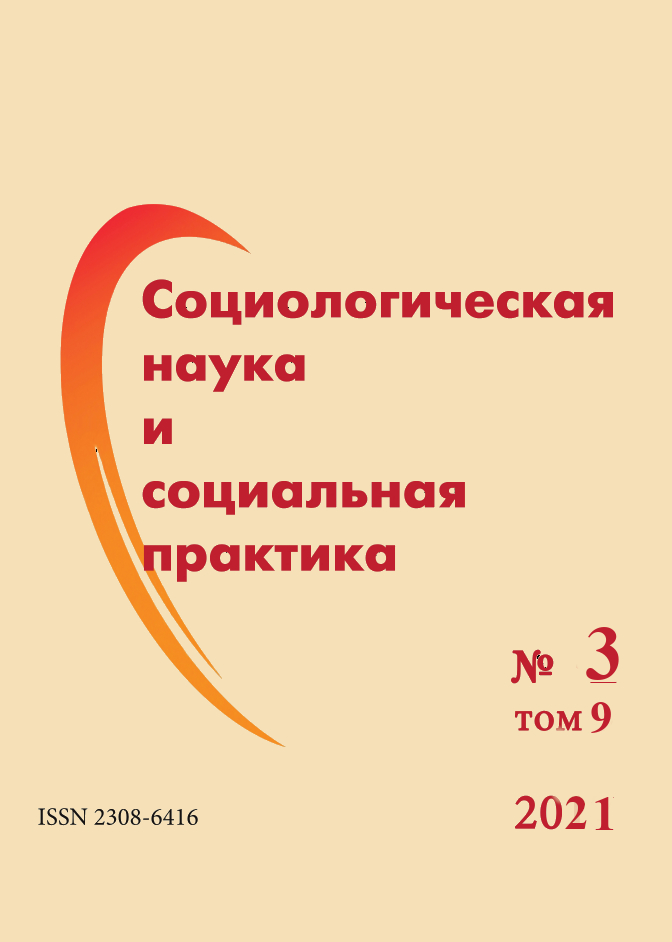Transformation of the Regional Social and Professional Space (on the Example of the Republic of Tyva)
Research Article
Abstract
References
2. Volovskaya N. M., Plyusnina L. K., Rusina A. V., Inozemtseva A. V. (2018). Bezrabotitsa i samozanyatost’: ozhidaniya i realii (po materialam sotsiologicheskikh issledovanij). [Unemployment and self-employment: expectations and realities (based on the materials of sociological research)]. Teoriya i praktika obschestvennogo razvitiya. № 11 (129). P. 22–31. DOI: 10.24158/tipor.2018.11.3 (In Russ.).
3. Golenkova Z. T., Goliusova Yu. V., Gorina T. I. (2020). Sotsiologicheskij portret samozanyatykh v sovremennoj Rossii. [A sociological portrait of the self-employed in modern Russia]. Vestnik Rossijskogo universiteta druzhby narodov. Seriya : Sotsiologiya. Vol. 20, № 4. P. 821–836. DOI: 10.22363/2313-2272-2020-20-4-821-836 (In Russ.).
4. Zemlyanukhina S. G., Zemlyanukhina N. S. (2018). Sistema ekonomicheskikh otnoshenij v sfere samozanyatosti naseleniya Rossii. [The system of economic relations in the field of self-employment of the Russian population]. Izvestiya Saratovskogo universiteta. Novaya seriya. Seriya : Ekonomika. Upravlenie. Pravo. Vol. 18, № 2. P. 126–133. DOI: 10.18500/1994-2540-2018-18-2-126-133 (In Russ.).
5. Zemlyanukhina S. G., Maksimovich L. V. (2007). Samozanyatost’ naseleniya v rossijskoj ekonomike: formirovanie i regulirovanie. [Self-employment of the population in the Russian economy: formation and regulation]. Saratov : Saratovskij gos. tekhnicheskij un-t publ. 145 p. (In Russ.).
6. Kryukova E. S., Ruzanova V. D. (2018). Individual’nyj predprinimatel’ i samozanyatyj grazhdanin: sootnoshenie ponyatij. [Individual entrepreneur and self-employed citizen: the correlation of concepts]. Zakony Rossii: opyt, analiz, praktika. № 3. P. 21–26. (In Russ.).
7. Kyrgys Z. K. (2002). Tuvinskoe gorlovoe penie : Etnomuzykovedcheskoe issledovanie. [Tuvan throat singing: Ethnomusicological research]. Novosibirsk : Nauka publ. 236 p. (In Russ.).
8. Maloun T. U. (2006). Trud v novom stoletii. Kak novye formy biznesa vliyayut na organizatsii, stil’ upravleniya i vashu zhizn’. [Labor in the new century. How new forms of business affect organizations, management style and your life]. M. : Olimp-biznes publ. 272 p. (In Russ.).
9. Samba A. D-B. (2020). Osnovnye izmeneniya v sotsial’no-trudovom prostranstve Respubliki Tyva. [The main changes in the social and labor space of the Republic of Tyva]. Ekonomika i upravlenie: nauchno-prakticheskij zhurnal. № 1 (151). P. 47–50. DOI: 10.34773/EU.2020.1.12 (In Russ.).
10. Sotsial’no-stratifikatsionnye protsessy v Respublike Tyva. (2020). [Социальностратификационные процессы в Республике Тыва]. Ed. by Z. T. Golenkova Yu. V. Goliusova, P. E. Sushko. M. : FNISTS RAN publ. 128 p. (In Russ.).
11. Sotsiologicheskaya entsiklopediya: V 2 t. T. 2. (2003). [The Sociological Encyclopedia: In 2 vols. Vol. 2]. Natsional’nyj obschestvenno-nauchnyj fond / Ed. by V. N. Ivanov. M. : Mysl’ publ. 863 p. (In Russ.).
12. Yubilejnyj statisticheskij sbornik k 100-letiyu edineniya Rossii i Tyvy : Stat. sbornik. (2014). [Yubileyny statistical collection for the 100th anniversary of the unity of Russia and Tyva]. Tyvastat. Kyzyl, 208 p. (In Russ.).
13. Respublika Tyva v tsifrakh 2019 : Stat. sbornik. (2020). [The Republic of Tyva in numbers 2019]. Krasnoyarskstat. Kyzyl publ. 151 p. (In Russ.).
Received: 26.04.2021
Accepted: 28.09.2021








 Publisher: Federal Center of Theoretical and Applied Sociology of the Russian Academy of Sciences (FCTAS RAS)
Publisher: Federal Center of Theoretical and Applied Sociology of the Russian Academy of Sciences (FCTAS RAS)